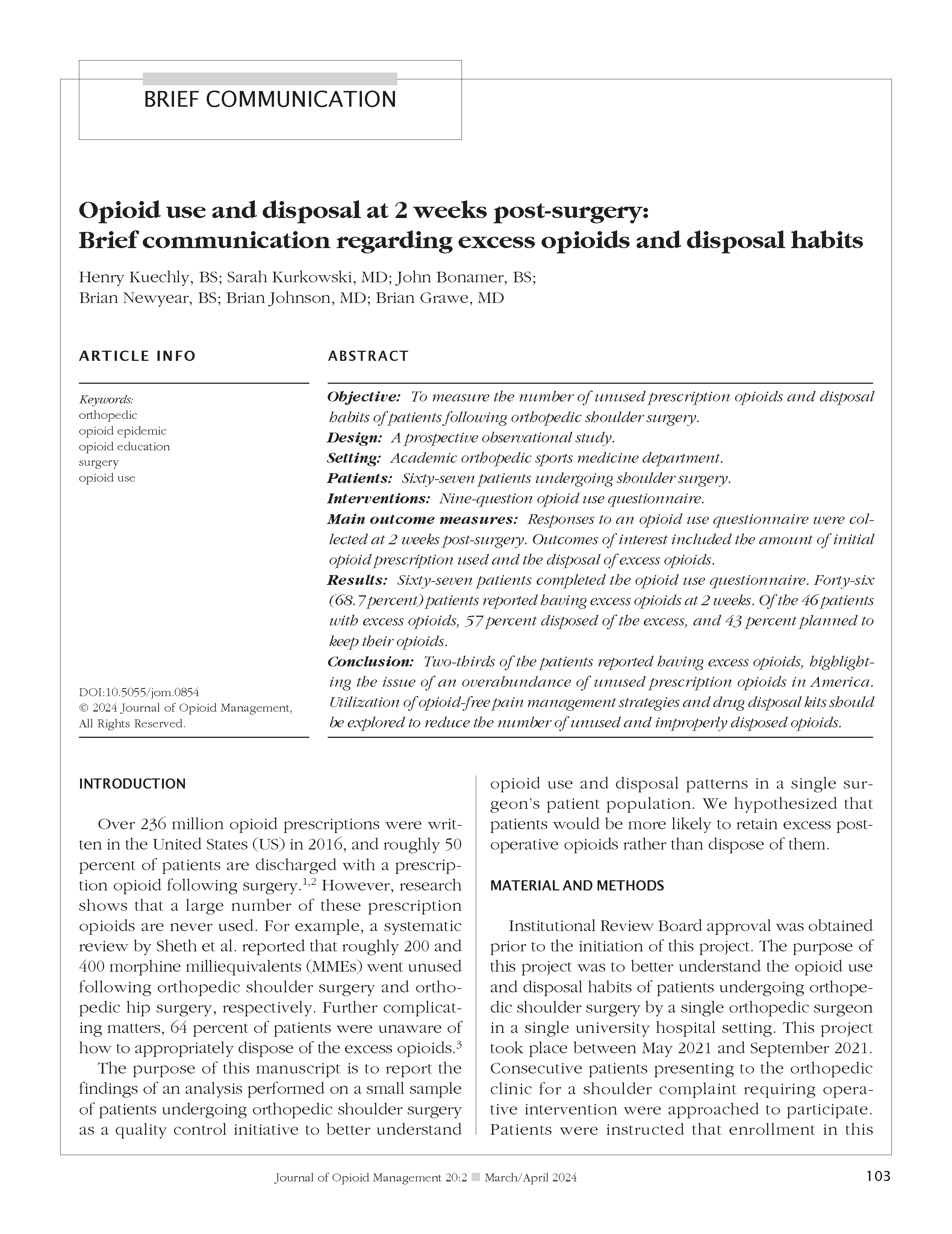Opioid use and disposal at 2 weeks post-surgery: Brief communication regarding excess opioids and disposal habits
DOI:
https://doi.org/10.5055/jom.0854Keywords:
orthopedic, opioid epidemic, opioid education, surgery, opioid useAbstract
Objective: To measure the number of unused prescription opioids and disposal habits of patients following orthopedic shoulder surgery.
Design: A prospective observational study.
Setting: Academic orthopedic sports medicine department.
Patients: Sixty-seven patients undergoing shoulder surgery.
Interventions: Nine-question opioid use questionnaire.
Main outcome measures: Responses to an opioid use questionnaire were collected at 2 weeks post-surgery. Outcomes of interest included the amount of initial opioid prescription used and the disposal of excess opioids.
Results: Sixty-seven patients completed the opioid use questionnaire. Forty-six (68.7 percent) patients reported having excess opioids at 2 weeks. Of the 46 patients with excess opioids, 57 percent disposed of the excess, and 43 percent planned to keep their opioids.
Conclusion: Two-thirds of the patients reported having excess opioids, highlighting the issue of an overabundance of unused prescription opioids in America. Utilization of opioid-free pain management strategies and drug disposal kits should be explored to reduce the number of unused and improperly disposed opioids.
References
Clarke H, Soneji N, Ko DT, et al.: Rates and risk factors for prolonged opioid use after major surgery: Population based cohort study. BMJ. 2014; 348(3): g1251-g1251. DOI: https://doi.org/10.1136/bmj.g1251
Centers for Disease Control and Prevention: Wide-ranging online data for epidemiologic research (WONDER). 2017. Available at https://healthdata.gov/dataset/wide-ranging-online-dataepidemiologic-research-wonder. Accessed October 1, 2023.
Sheth U, Mehta M, Huyke F, et al.: Opioid use after common sports medicine procedures: A systematic review. Sports Health. 2020; 12(3): 225-233. DOI: https://doi.org/10.1177/1941738120913293
Cheesman Q, DeFrance M, Stenson J, et al.: The effect of preoperative education on opioid consumption in patients undergoing arthroscopic rotator cuff repair: A prospective, randomized clinical trial-2-year follow-up. J Shoulder Elbow Surg. 2020; 29(9): 1743-1750. DOI: https://doi.org/10.1016/j.jse.2020.04.036
Farley KX, Anastasio AT, Kumar A, et al.: Association between quantity of opioids prescribed after surgery or preoperative opioid use education with opioid consumption. JAMA. 2019; 321(24): 2465. DOI: https://doi.org/10.1001/jama.2019.6125
Rucinski K, Cook JL: Effects of preoperative opioid education on postoperative opioid use and pain management in orthopaedics: A systematic review. J Orthop. 2020; 20: 154-159. DOI: https://doi.org/10.1016/j.jor.2020.01.020
Syed UAM, Aleem AW, Wowkanech C, et al.: Neer award 2018: The effect of preoperative education on opioid consumption in patients undergoing arthroscopic rotator cuff repair: A prospective, randomized clinical trial. J Shoulder Elbow Surg. 2018; 27(6): 962-967. DOI: https://doi.org/10.1016/j.jse.2018.02.039
Sabesan VJ, Chatha K, Koen S, et al.: Innovative patient education and pain management protocols to achieve opioid-free shoulder arthroplasty. JSES Int. 2020; 4(2): 362-365. DOI: https://doi.org/10.1016/j.jseint.2020.01.005
Rodgers J, Cunningham K, Fitzgerald K, et al.: Opioid consumption following outpatient upper extremity surgery. J Hand Surg Am. 2012; 37(4): 645-650. DOI: https://doi.org/10.1016/j.jhsa.2012.01.035
Bates C, Laciak R, Southwick A, et al.: Over-prescription of postoperative narcotics: A look at postoperative pain medication delivery, consumption and disposal in urological practice. J Urol. 2011; 185(2): 551-555. DOI: https://doi.org/10.1016/j.juro.2010.09.088
Cabo J, Hsi RS, Scarpato KR: Postoperative opiate use in urological patients: A quality improvement study aimed at improving opiate disposal practices. J Urol. 2019; 201(2): 371-376. DOI: https://doi.org/10.1016/j.juro.2018.09.052
Bicket MC, Long JJ, Pronovost PJ, et al.: Prescription opioid analgesics commonly unused after surgery: A systematic review. JAMA Surg. 2017; 152(11): 1066-1071. DOI: https://doi.org/10.1001/jamasurg.2017.0831
Lawrence AE, Carsel AJ, Leonhart KL, et al.: Effect of drug disposal bag provision on proper disposal of unused opioids by families of pediatric surgical patients: A randomized clinical trial. JAMA Pediatr. 2019; 173(8): e191695. DOI: https://doi.org/10.1001/jamapediatrics.2019.1695
Dwyer CL, Soong M, Hunter A, et al.: Prospective evaluation of an opioid reduction protocol in hand surgery. J Hand Surg. 2018; 43(6): 516-522.e1. DOI: https://doi.org/10.1016/j.jhsa.2018.01.021
Hasak JM, Roth Bettlach CL, Santosa KB, et al.: Empowering post-surgical patients to improve opioid disposal: A before and after quality improvement study. J Am Coll Surg. 2018; 226(3): 235-240.e3. DOI: https://doi.org/10.1016/j.jamcollsurg.2017.11.023
Kumar K, Gulotta LV, Dines JS, et al.: Unused opioid pills after outpatient shoulder surgeries given current perioperative prescribing habits. Am J Sports Med. 2017; 45(3): 636-641. DOI: https://doi.org/10.1177/0363546517693665
Bartels K, Mayes LM, Dingmann C, et al.: Opioid use and storage patterns by patients after hospital discharge following surgery. PLoS One. 2016; 11(1): e0147972. DOI: https://doi.org/10.1371/journal.pone.0147972
Finger A, Teunis T, Hageman MG, et al.: Association between opioid intake and disability after surgical management of ankle fractures. J Am Acad Orthop Surg. 2017; 25(7): 519-526. DOI: https://doi.org/10.5435/JAAOS-D-16-00505
Wyles CC, Thiels CA, Hevesi M, et al.: Patient opioid requirements are often far less than their discharge prescription after orthopaedic surgery: The results of a prospective multicenter survey. J Am Acad Orthop Surg. 2021; 29(7): e345-e353. DOI: https://doi.org/10.5435/JAAOS-D-19-00415
US Department of Health and Human Services: Results from the 2010 National Survey on Drug Use and Health: Summary of National Findings. Rockville, MD: US Department of Health and Human Services, 2011.
Chapman CG, Hudspeth J, Floyd SB, et al.: Increased opioid use following rotator cuff repair associated with prior opioid use and surgeon prescription patterns. J Shoulder Elbow Surg. 2020; 29(7s): S115-S125. DOI: https://doi.org/10.1016/j.jse.2020.04.037
Sethi PM, Brameier DT, Mandava NK, et al.: Liposomal bupivacaine reduces opiate consumption after rotator cuff repair in a randomized controlled trial. J Shoulder Elbow Surg. 2019; 28(5): 819-827. DOI: https://doi.org/10.1016/j.jse.2019.01.008
Lamplot JD, Premkumar A, James EW, et al.: Postoperative disposal of unused opioids: A systematic review. HSS J. 2021; 17(2): 235-243. DOI: https://doi.org/10.1177/15563316211001366
Stokes SM, Kim RY, Jacobs A, et al.: Home disposal kits for leftover opioid medications after surgery: Do they work? J Surg Res. 2020; 245: 396-402. DOI: https://doi.org/10.1016/j.jss.2019.07.034

Published
How to Cite
Issue
Section
License
Copyright 2005-2025, Weston Medical Publishing, LLC and Journal of Opioid Management. All Rights Reserved.










